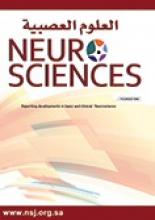Abstract
OBJECTIVE: To study a large Sudanese family with a progressive autosomal dominant cerebellar ataxia and describe the clinical features and identify the genotype of the disorder.
METHODS: This study was conducted during the year 1999 in the University Neurology Department of Shaab Teaching Hospital in Khartoum, Sudan. Affected individuals were identified by clinical examination or by reliable narrative data obtained from relatives of diseased or inaccessible family members. Routine laboratory blood and urine tests, cerebrospinal fluid analysis, cranial computerized tomography and nerve conduction studies were performed on the index patient and, if possible, family members. The genotype was identified by deoxyribonucleic acid analysis.
RESULTS: Ten males and 12 females spanning 4 generations were affected by autosomal dominant spinocerebellar ataxia. Genetic studies identified the mutation to be at the spinocerebellar ataxia 1 locus on chromosome p6.
CONCLUSION: This is a report of a Sudanese family suffering from Type 1 autosomal dominant spinocerebellar ataxia.
- Copyright: © Neurosciences
Neurosciences is an Open Access journal and articles published are distributed under the terms of the Creative Commons Attribution-NonCommercial License (CC BY-NC). Readers may copy, distribute, and display the work for non-commercial purposes with the proper citation of the original work.






